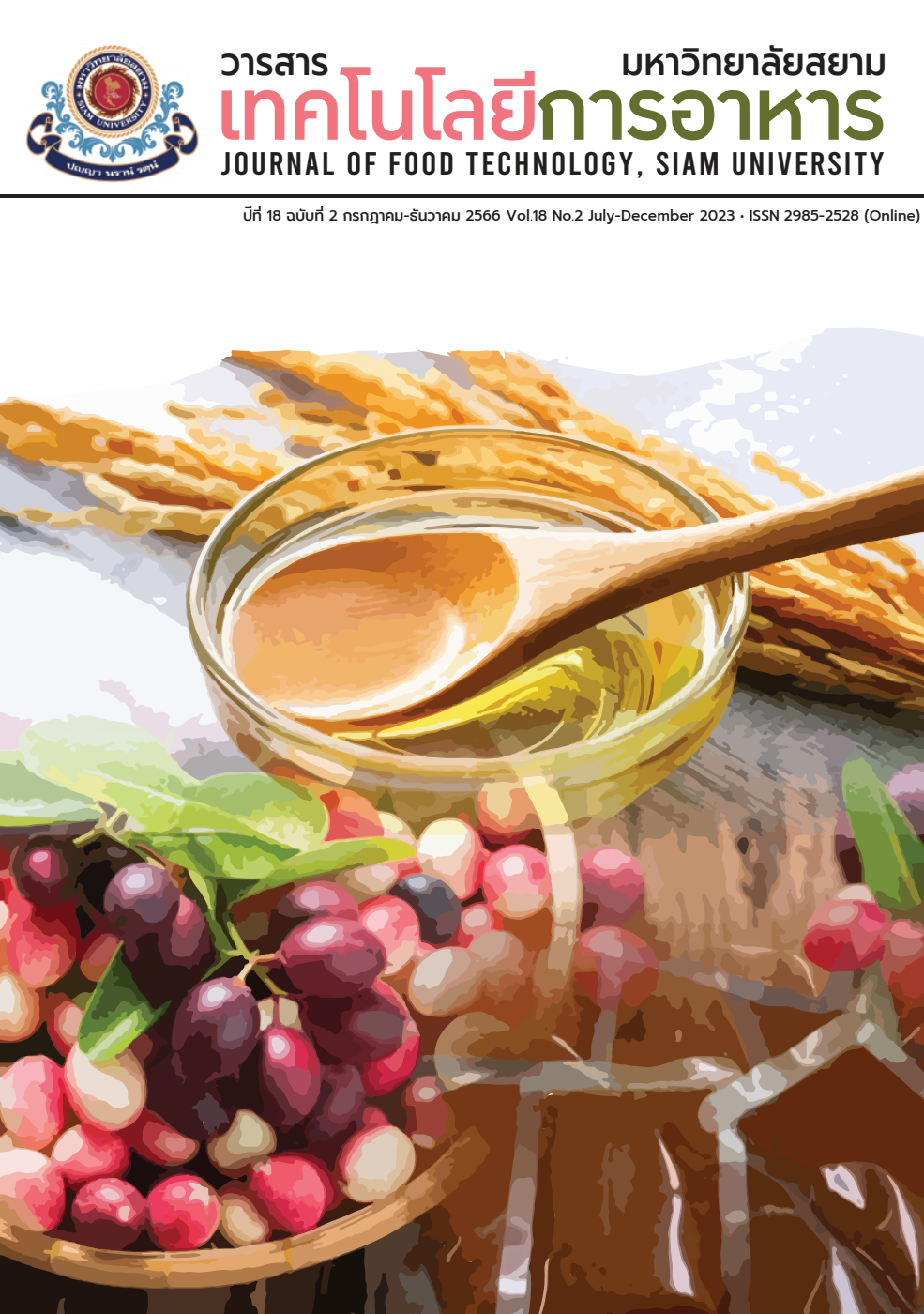ระยะเวลาการให้ความร้อนและอุณหภูมิในการเก็บต่อคุณภาพและการยืดอายุการเก็บรักษา พริกแกงกอและ
Main Article Content
บทคัดย่อ
งานวิจัยนี้มีวัตถุประสงค์เพื่อศึกษาระยะเวลาการให้ความร้อน (15 และ 30 นาที) และอุณหภูมิในการเก็บรักษา (4 และ 27 องศาเซลเซียส) ต่ออายุการเก็บรักษาพริกแกงกอและ โดยศึกษาการเปลี่ยนแปลงลักษณะทางกายภาพ เคมี จุลินทรีย์ และการทดสอบการยอมรับทางประสาทสัมผัส ผลการศึกษาพบว่าระยะเวลาการให้ความร้อน อุณหภูมิการเก็บรักษา และระยะเวลาการเก็บรักษาส่งผลให้ค่าความเป็นกรดด่างของพริกแกงเกิดการเปลี่ยนแปลง (p<0.05) ระยะเวลาการให้ความร้อนที่เพิ่มขึ้นส่งผลให้ค่าความสว่างและค่าสีเหลืองในพริกแกงเพิ่มขึ้น (p<0.05) ระยะเวลาการเก็บรักษาที่นานขึ้นส่งผลให้ค่าสีเหลืองในพริกแกงเพิ่มขึ้น แต่ส่งผลให้ค่าสีแดงในพริกแกงลดลง (p<0.05) และการเก็บที่อุณหภูมิห้องส่งผลให้ค่าสีแดงในพริกแกงลดลงมากกว่าการเก็บอุณหภูมิ 4 องศาเซลเซียส (p<0.05) อย่างไรก็ตามระยะเวลาการให้ความร้อน อุณหภูมิในการเก็บรักษา และระยะเวลาการเก็บรักษา ไม่มีผลต่อค่าปริมาณน้ำอิสระในพริกแกง และคะแนนการยอมรับทางประสาทสัมผัส (p≥0.05) ซึ่งการให้ความร้อนสามารถลดปริมาณจุลินทรีย์ทั้งหมด ยีสต์และรา ลงได้ 0.5-1.5 log CFU/g โดยพริกแกงที่ผ่านการให้ความร้อน 15 และ 30 นาที สามารถเก็บรักษาที่อุณหภูมิห้องได้เป็นเวลา 3 และ 4 สัปดาห์ ตามลำดับ ในขณะที่พริกแกงที่ผ่านการให้ความร้อนและเก็บรักษาที่อุณหภูมิ 4 องศาเซลเซียส สามารถเก็บรักษาได้นานมากกว่า 5 สัปดาห์
Article Details

อนุญาตภายใต้เงื่อนไข Creative Commons Attribution-NonCommercial-NoDerivatives 4.0 International License.
บทความทุกบทความในวารสารเทคโนโลยีการอาหาร ทั้งในรูปแบบสิ่งพิมพ์ และในระบบออนไลน์ ถือเป็นลิขสิทธิ์ของมหาวิทยาลัยสยาม และได้รับการคุ้มครองตามกฎหมาย
เอกสารอ้างอิง
Pakdeechanuan, P., Supraksorn, P., Soison B. and Numuang, C. (2017). Effect of sous vide technique and nitrite on qualities of Golek chicken product. KKU Science Journal. 45(4): 914-923. (in Thai).
Sukjantra, J., Vonghirundacha, N. and Ketpanyapong, W. (2006). Local wisdom of production Kai-Kholae from Toongpla community Pattani province. Journal of Yala Rajabhat University. 1(1): 56-64. (in Thai).
Thai Industrial Standards Institute. (2013). Thai community product standard: Namphrik Keang, TCPS. 129-2556. (in Thai).
Filipa, V. and Silva, M. (2004). Target selection in designing pasteurization processes for shelf-stable high-acid fruit products. Critical Reviews in Food Science and Nutrition. 44:353–360.
Ramaswamy, H.S. and Abbatemarco, C. (1996). Thermal processing of fruits. In L. P. Somogyi, H. S. Ramaswamy and Y. H. Hui (eds.), Processing fruits: Science and technology (pp. 25–65). Technomic Publishing Co., Inc., Lancaster Basel.
Tasaudom, U., Srapinkaraburi, W. and Nipronrum, S. (2009). The production improvement for shelf-life extension of chili paste products. Naresuan University Journal. 17(2): 136-144. (in Thai).
Apirattananusorn, S. and Chinabhark, K. (2013). Development of packages for ready-to-Eat chili paste products. KMUTT Research and Development. 36(4): 451-464. (in Thai).
BAM. (2023). Bacteriological Analytical Manual (BAM). [Online] Available from https://www.fda.gov/food/laboratory-methods-food/bacteriological-analytical-manual-bam. [Accessed April 2, 2023].
Siripongvutikorn, S., Pengseng, N., Ayusuk, S. and Usawakesmanee, W. (2008). Development of green curry paste marinade for white shrimp (Litopenaeus vannamei). Songklanakarin Journal of Science and Technology. 30(1): 35-40.
Bartolomk, A. P., Rupbrez, P. and Fhster, C. (1995). Pineapple fruit: morphological characteristics, chemical composition and sensory analysis of red spanish and smooth cayenne cultivars. Food Chemistry. 53: 75-79.
Abolhassani, Y., Ayub, M.K. and Babji, A.S. (2009). Assessment of microbiological and modified aroma profiles of lactic acid bacteria (LAB) fermented curry paste. Asian Journal of Food and Agro-Industry. 2(2): 63-71.
Ifesan, B.O.T. and Siripongvutikorn, S., Thummaratwasik, P. and Kanthachot, D. (2010). Stability of antibacterial property of Thai green curry during chilled storage. Journal of Food Processing and Preservation 34: 308–321.
Li, Y., Brackett, R.E., Shewfelt, R.L. and Beuchat, L.R. (2001). Changes in appearance and natural microflora on iceberg lettuce treated in warm, chlorinated water and then stored at refrigeration temperature. Food Microbiology. 18: 299–308.
Giese, J. (1994). Spices and seasoning blends, a taste for all season. Food Technology. 48: 87–98.
Kneifel, W. and Berger, E. (1994). Microbial criteria of random samples of spices and herbs retailed on the Austrian market. Journal of Food Protection. 57: 893–901.
Promjiam, P., Siripongvutikorn, S., Usawakesmanee, W. and Wichienchot, S. (2013). Effect of added garcinia fruit on total phenolic compound content, antioxidant properties and quality changes of the southern sour curry paste, Keang-hleung, during storage. Food and Nutrition Sciences. 4: 812-820.
Axelsson, L. (2004). Lactic acid bacteria: classification and physiology. In S. Salminen, A.V. Wright and A. Ouwehand (eds.), Lactic acid bacteria microbiological and functional aspects (pp. 1-16). Marcel Dekker, CRC Press, New York.
Maki, M. (2004). Lactic acid bacteria in vegetable fermentations. In S. Salminen, A. V. Wright and A. Ouwehand (eds.), Lactic acid bacteria microbiological and functional aspects (pp. 419-430). Marcel Dekker, CRC Press, New York.
Ghoddusi, H.B., Sherburn, R.E. and Aboaba, O.O. (2013). Growth limiting pH, water activity, and temperature for neurotoxigenic strains of Clostridium butyricum. Microbiology. 2013: 731430.
Yang, S.T., Yu, M., Chang, W.L. and Tang, I.C. (2013). Anaerobic fermentations for the production of acetic and butyric acids. In S.T. Yang, H.A. El-Enshasy and N. Thongchul (eds.), Bioprocessing technologies in biorefinery for sustainable production of fuels, chemicals, and polymers (pp. 351-374). John Willey and Sons, Inc., New Jersey.
Odeyemi, O.A., Alegbeleye, O.O., Strateva, M. and Stratev, D. (2020). Understanding spoilage microbial community and spoilage mechanisms in foods of animal origin. Comprehensive Reviews in Food Science and Food Safety. 19(2): 311-331.
Huis In’t Veld, J.H.J. (1996). Microbial and biochemical spoilage of foods: an overview. International Journal of Food Microbiology. 33: 1-18.
Bozin, B., Dukic, N.M., Samojlik, I., Goran, A. and Igic, R. (2008). Phenolics as antioxidants in garlic (Allium sativum L., Alliaceae). Food Chemistry. 111: 925–929.
Inchuen, S., Narkrugsa, W. and Pornchaloempong, P. (2010). Effect of drying methods on chemical composition, color and antioxidant properties of Thai red curry powder. Kasetsart Journal (Natural Science). 44: 142 – 151.
Ahmed, J., Shivhare, U.S. and Ramaswamy, H.S. (2002). A fraction conversion kinetic model for thermal degradation of color in red chili puree and paste. LWT. 35: 497-503.
Lamikanra, O. and Watson, M.A. (2000). Cantaloupe melon peroxidase: characterization and effects of additives on activity. Molecular Nutrition and Food Research. 44(3): 168-172.
Voroquaux, P. and Wiley, R.C. (1994). Biological and biochemical changes in minimally processed refrigerated fruits and vegetables. In R.C. Wiley (ed.), Minimally processed refrigerated fruits and vegetables (pp. 226-268). Chapman and Hall, CRC Press, New York.
Bonnie, T.Y.P. and Choo, Y.M. (1999). Oxidation and thermal degradation of carotenoids. Journal of Oil Palm Research. 2(1): 62-78.
Chang, Q., Zuo, Z., Chow, M.S.S. and Ho, W.K.K. (2006). Effect of storage temperature on phenolics stability in hawthorn (Crataegus pinnatifida var. major) fruits and a hawthorn drink. Food Chemistry. 98: 426–430.
Concellon, A., Anon, M.C. and Chaves, A.R. (2004). Characterization and changes in polyphenol oxidase from eggplant fruit (Solanum melongena L.) during storage at low temperature. Food Chemistry. 88(1): 17-24.
Anguelova, T. and Warthesen, J. (2000). Degradation of lycopene, α-carotene, and β-carotene during lipid peroxidation. Food Chemistry and Toxicology. 65(1): 71-75.


